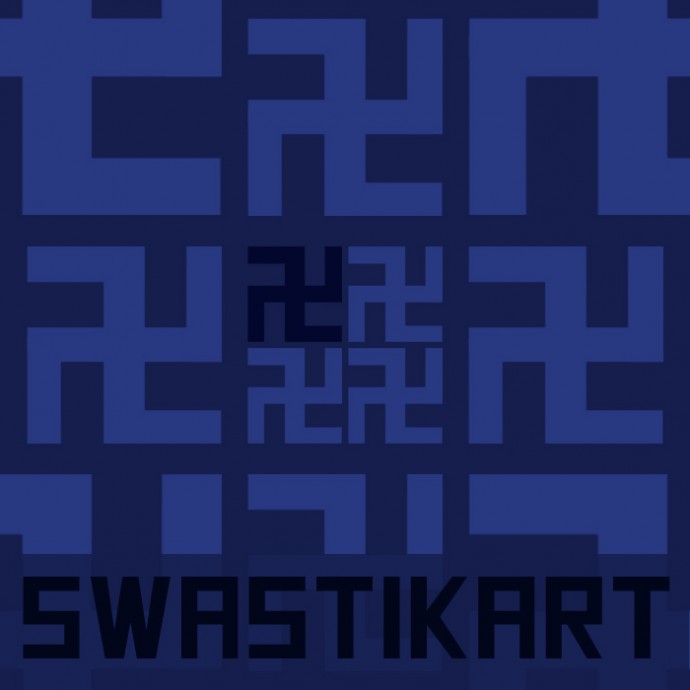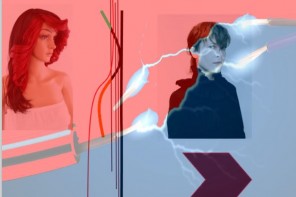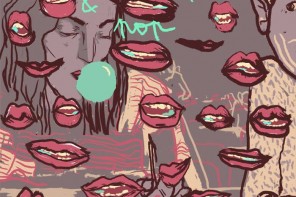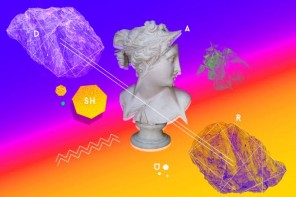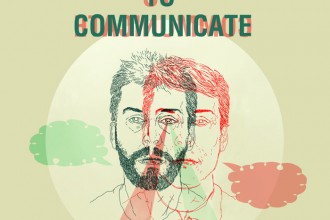Boz Mugabe is a surreal artist from Dublin and the administrator of the “Gentle Swastika” blog. His work features creepy tribal figures and heavy symbology, the Swastika, amongst other images make a recurring appearance. Swastikas can be an image of controversy and Boz explains the relationship between the Swastika and his artworks.
I am an artist. I come from an underground/punk publishing background and utilised swastikas in antagonistic graphics from the early ‘90s, particularly in regard to anti-church sentiment. As this progressed, I started to pervert these ideas into a more ambiguous area and at the same time I was learning about the swastika in antiquity through history and archeology books that I was using as research material. My first encounter with Swastikas outside of cinema about nazis or comic books was the martial industrial band, Laibach’s use of it in heraldic form on the sleeve and labels of their OPUS DEI album. Because of Laibach’s very playful intelligence, it was obvious that there was a greater scale to the history of this symbol that I may not have realised before then. This led on to an exposure to the symbol in the context of Greco-Roman antiquity. My brother was studying ancient history and archeology and this information was readily at my disposal – I still have his Greek art text book to this day! The whole thing just morphed from there and remained as a mechanism in my drawing style. I don’t think it has any effect on me as a person, although I notice that people who don’t know me make all sorts of assumptions to the contrary, for whatever that’s worth.
I like all the speculated and documented purposes the Swastika symbol has served in its true sense, but I am observing history and cultural anthropology, not looking for spirituality. So to me it’s geometry, plain and simple. There are some interesting theories regarding its migration in the ancient world, but this slips into ‘Erich Von Daniken’ territory very quickly and I’m too busy with reality to be taken in by science fiction or pseudo spirituality. The fact of it being a symbol generated simultaneously by many different, apparently unconnected, civilizations is certainly fascinating, but could probably be better explained by a math psychologist than some YouTube crackpot with an ancient alien fixation.
I use the Swastika in my art along with many other motifs (some of my own creation and some collected along the way), but the Swastika tends to be a detail that a certain type of person zones in on or gets hung up on very easily. I don’t really involve myself in lifting the negative associations because as far as I’m concerned, they weren’t there in the first place. The Internet is flooded with all the information you can possibly want about the Swastika so I don’t burden myself if someone is too mentally lazy to learn. It’s easier to let these people believe what they want. I genuinely believe people cling on to negativity because it’s what they enjoy. I have experienced a lot of negativity over the last 20+ years of having art somewhat in the public eye but as I am not opinion driven, it has little effect on me. Unfortunately for anyone who makes an issue of it, I’ve done my research. I have encountered situations where people question what I’m doing, quite often in a fairly arrogant manner. These might be people who went backpacking to Thailand once, saw a Swastika on a temple and therefore consider themselves an encyclopedia on the subject. I have a great interest in ancient art and archaeology and this tends to be a rich source of research.
It has been suggested once or twice that I could have an information sheet on the Swastika at my exhibitions but I consider this to be unnecessarily apologetic and defensive when the artwork itself is not about swastikas, they’re simply a small part of it. It’s fairly obvious my work is very labour intensive – a larger piece may typically take a month – and I guess what baffles me the most is that someone might be of the opinion that I haven’t used that time to think about what I’m doing and why I’m doing it? I was always very repelled by art I saw in Ireland that was meek and apologetic, where the artist would say their work was about “the frailty of humanity” and “the passage of time” (whatever that means). These people should be making paper doilies, not art. I always thought that art should be about visual and conceptual vitality and strength and have a vivid and assured sense of itself, not be an apologetic, frail, wheezing effort. This is where the Swastika comes in. I treat it like a visual multivitamin. The Swastika means a lot of things in my work; life cycle, strength, movement, energy points, even just as a decorative tool. I like it to be open to interpretation in context to the entire work. I don’t really feel affected when people project negativity upon my work. While it is bad in one sense, having a certain reputation as an artist is invaluable. To me, being bland, inert and subservient to a “market” is more offensive. Maybe meek art does serve some people but I’m interested in art that has a resonance I can relate to. Something twisted and energetic like a decent Basquait painting (he painted a lot of shit too) has more soul in it than a technically excellent impressionist masterpiece of a countryside landscape.
What draws me to the Swastika is versatility, strength, motion and history. I don’t play on the duality of it (although I used to when I was involved in underground publishing in the 1990s). I don’t see myself as an educator. I’m doing this to learn. The swastika inhabits my art but is a very small detail in a larger image, I don’t require that people understand anything specific about it beyond what they take from the entire artwork. If they already know about it or if they subsequently do some reading on it then that’s a positive thing. If they don’t understand and don’t want to understand then there are probably other places they can be; sitting at home shouting at football on the TV or watching bad porn on the internet or whatever.
If there’s some understanding or reason behind the use of symbols then they’re definitely personal: Whether it’s rosary beads, a Ganesha statue, Swastika, dressing a certain way, prison tattoos or whatever. Symbols only cease to be personal when they’re all about material affluence (expensive cars, designer clothing) or blind association (wanting the same tattoo David Beckham has). I don’t really like to offer up an interpretation of my work for a number of reasons. The main one would be because, by producing the images, I’m also trying to figure things out; this doesn’t put me in the position offer explanations. Maybe other people’s ideas of what the works represent are better. Life is short. My drive is to not waste that time in a substandard manner by being a spectator and watching other people being creative. There’s only a finite amount of these pictures I can do so I’ve got to be busy.
A large mono-coloured canvas can be just as effective in provoking a reaction as art containing Swastikas, although the reasons for this may differ vastly – the ultimate purpose of art is to project something of a civilising effect, not to provoke. I’m not interested in the academic or intellectual side of this because those elements justify bad conceptual art and pointlessly alienate people, and I’m not trying to alienate or provoke anyone. I simply try to keep everything as instinctive and primal as possible.

